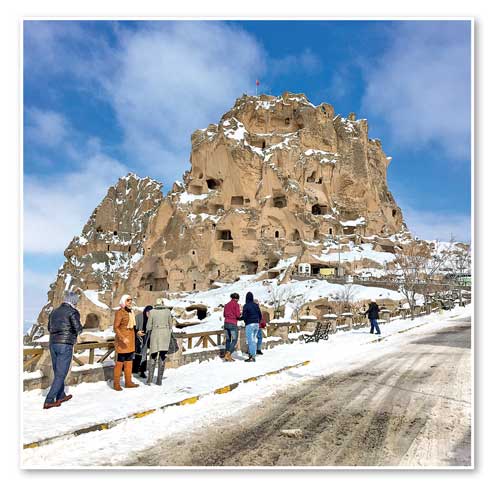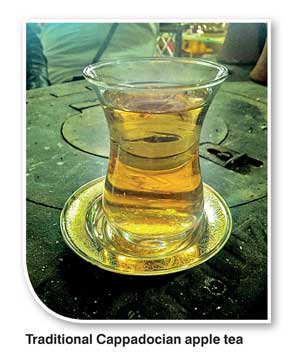Friday Dec 19, 2025
Friday Dec 19, 2025
Saturday, 17 December 2016 00:00 - - {{hitsCtrl.values.hits}}
By Aysha Maryam Cassim
A couple of months ago, Michiel Huisman (Daario Naharais from ‘Game of Thrones’) posted a few of his onset Instagrams which were hash-tagged #ShootingInCappadocia. Seeing one of the actors whom I admire the most in one of my favourite places on earth left me awestruck, making ‘Mountains and Stones’ a movie worth looking forward to this year.
Cappadocia is a geological wonderland. The rugged, rocky maze, honeycombed with a network of caves makes it a ravishing cinematic backdrop for filmmakers. During the flight to Istanbul, I whiled away the hours up in the air watching ‘Winter Sleep,’ a Turkish drama film shot in the mind-bending landscapes of Cappadocia. This masterpiece by Nuri Bilge Ceylan, which won the prestigious Palme d’Or at the Cannes Film Festival 2014, revolves around a landlord named Aydin and his melancholic life during an unavoidable winter in Kapadokya.
Volcanoes were the architects of Cappadocia. Many millennia ago, in the geological period, volcanoes erupted repeatedly, sculpting the landscape with wind and floodwater causing a geological marvel to be emerged. The astounding fairy chimneys and canyons that we see today are the result of layers of sedimentation exposed by erosion. Fairy chimneys are generally found in the valleys of Uçhisar, Ürgüp -Avanos touristic triangle.
Termite mounds are a marvel of insect engineering. The well-structured dirt fortresses consist of bubble-like chambers connected to branching passages. When my eyes first caught the glance of honeycombed rock formations of Cappadocia, I felt like colossus termite mounds surrounded me. During the winter, the snowfall had rendered the plateau picturesque to resemble sugar dusted Hershey’s kisses. It was truly a celestial beauty.
Yabba-dabba-doooo! Cappadocian Flintstones 
The first inhabitants of Cappadocia were hunters and gatherers. The natural caves were used as storage for food brought from the Mediterranean. They fed on wild plants and used hunting tools made of obsidian and flint stone. The nomads sought sanctuary in the dwellings carved out of the ubiquitous soft stone, which kept them lukewarm during the winter and cool in the summer.
Over the years, the inhabitants have transformed their lairs into meticulously designed cave rooms and hotels. We spent a night in a cave-inn named Ali Bey Konak, located in the serene town of Uçhisar. Mehmet, the proprietor of the hotel, and his wife welcomed us with warmth and sincerity and ensured that we have a comfortable stay to enjoy the surrounding scenery in a quiet, laidback atmosphere.
Uçhisar
Uçhisar is situated at the highest point in Cappadocia, on the Nev ehir-Göreme road, just 5km from Nev ehir. It is well known for its rock citadel, which provides a magnificent panorama of the whole of Cappadocia, over to Mount Erciyes. The touristic village and the maze of small cobble stoned streets lined up with cave hotels is ideally suited for independent travellers seeking peace and quiet.
Cappadocian cave men and potters
The small town of Avanos is known as the epicentre of earthenware pottery since the Hittites. The artisan potters of the village and their skills have mostly been handed down from generation to generation. The roots of their profession lie in the nearby red river Kizilirmak, which flows through the town where the reddish-brown clay is harvested, then used in workshops throughout Avanos. Visitors can watch maestros at work and purchase authentic pieces of remarkable quality.
I met Aydin, a young man from Avanos who has his own souvenir shop in Uçhisar. We went in to his underground cave store to seek shelter from the nasty blizzard outside. It was a charming aesthetic cocoon. Complying with the traditional Turkish custom, Aydin and his cousin greeted us with a cup of homemade apple tea. As always, we were overwhelmed by their utmost hospitality towards travellers.
We browsed through an extensive inventory of beautifully glazed ceramic and earthenware. The handmade white ware was intricately detailed with lustrous colours. Most of them cost more than thousands of dollars due to the intense laborious skills involved.
Turquoise (Turkish Stone) has always been one of my favourite hues of blue. So my eyes fancied the dark blue glazed turquoise pieces, which were strategically placed on the earthen walls. The depth and the vibrancy of its colours captivated me.
En route to Göreme
The cultural life of Cappadocia has been shaped by the values and morals of the diverse cultures it has hosted over hundreds of years under Hattians, Hitties, Hellens, Romans, Byzantines and Turks.
Cappadocia was listed as the 357th property in the UNESCO World Heritage List as “Göreme National Park and the Rock Sites of Cappadocia”. The region received its recognition thanks to its extraordinary natural rock formations, archaeological excavations and cultural assets dating from the Bronze Age.
Cappadocia flourished under many great civilisations. The communities who lived here witnessed different ethnic communities merging together and excellent examples of mutual courtesy and tolerance.
By the end of the 2nd century, during the early days of Christianity, Cappadocia became a site for religious refuge. The place where religious education was started it presently known as Göreme Open Air Museum. Cave monasteries, hewn out of the rock constituted an ideal place of worship for monks and monastic colonies who chose to retreat here. You would find beautiful frescoed paintings in cave chapels dating back to Byzantine era, which endure in well-preserved isolation to this day.
The village of Göreme is set right in the heart of the valleys. The pinnacles of stunning rock formations and celestial landscapes surround the booming tourist hub of Göreme. The monuments of unsurpassed grandeur and the rugged backdrop of mounts and valleys make it a perfect base for backpackers. Göreme now boasts opulent hotels, pensions, cafés, bars, travel agencies and hot air balloon companies aiming to cater to the upmarket tourist clientele.
The high plateau of central Anatolia is brimming with archaeological and geographical splendours. One of the best ways to see Cappadocia is from a hot air balloon, hovering over the panoramic valleys and sweeping curves. Today, Cappadocia is more celebrated for its extraordinary topography and skylines dappled with hot air balloons.
Since the beginning of the 18th century travellers from East and West have been flocking around to this fairy-tale country, intrigued by the mysterious atmosphere of Cappadocia. I wanted to get lost in this surreal moonscape and that is exactly the reason that bought me here.